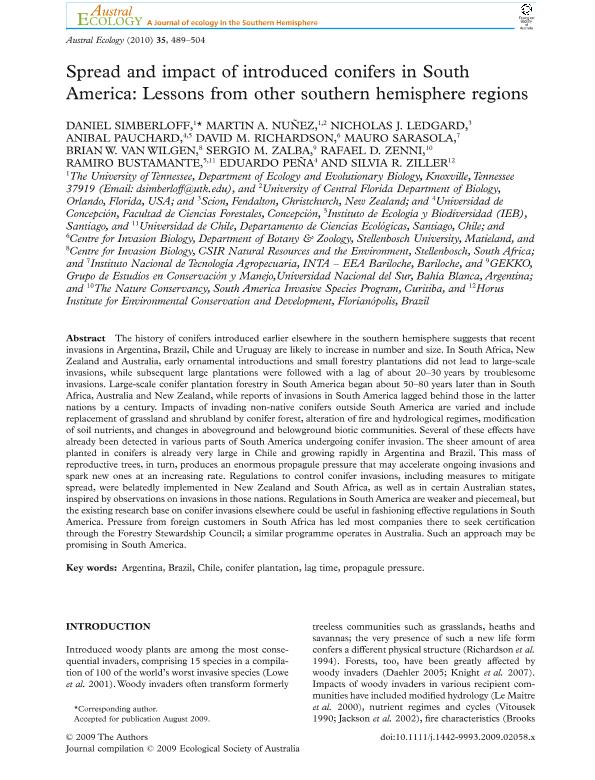Artículo
Spread and impact of introduced conifers in South America: Lessons from other southern hemisphere regions
Simberloff, Daniel; Nuñez, Martín A.; Ledgard, Nicolas J.; Pauchard, Anibal; Richardson, David M.; Sarasola, Mauro; Van Wilgen, Brian W.; Zalba, Sergio Martín ; Zenni, Rafael D.; Bustamante, Ramiro; Peña, Eduardo; Ziller, Silvia R.
; Zenni, Rafael D.; Bustamante, Ramiro; Peña, Eduardo; Ziller, Silvia R.
 ; Zenni, Rafael D.; Bustamante, Ramiro; Peña, Eduardo; Ziller, Silvia R.
; Zenni, Rafael D.; Bustamante, Ramiro; Peña, Eduardo; Ziller, Silvia R.
Fecha de publicación:
20/07/2010
Editorial:
Wiley Blackwell Publishing, Inc
Revista:
Austral Ecology
ISSN:
1442-9985
Idioma:
Inglés
Tipo de recurso:
Artículo publicado
Clasificación temática:
Resumen
The history of conifers introduced earlier elsewhere in the southern hemisphere suggests that recent invasions in Argentina, Brazil, Chile and Uruguay are likely to increase in number and size. In South Africa, New Zealand and Australia, early ornamental introductions and small forestry plantations did not lead to large-scale invasions, while subsequent large plantations were followed with a lag of about 20–30 years by troublesome invasions. Large-scale conifer plantation forestry in South America began about 50–80 years later than in South Africa, Australia and New Zealand, while reports of invasions in South America lagged behind those in the latter nations by a century. Impacts of invading non-native conifers outside South America are varied and include replacement of grassland and shrubland by conifer forest, alteration of fire and hydrological regimes, modification of soil nutrients, and changes in aboveground and belowground biotic communities. Several of these effects have already been detected in various parts of South America undergoing conifer invasion. The sheer amount of area planted in conifers is already very large in Chile and growing rapidly in Argentina and Brazil. This mass of reproductive trees, in turn, produces an enormous propagule pressure that may accelerate ongoing invasions and spark new ones at an increasing rate. Regulations to control conifer invasions, including measures to mitigate spread, were belatedly implemented in New Zealand and South Africa, as well as in certain Australian states, inspired by observations on invasions in those nations. Regulations in South America are weaker and piecemeal, but the existing research base on conifer invasions elsewhere could be useful in fashioning effective regulations in South America. Pressure from foreign customers in South Africa has led most companies there to seek certification through the Forestry Stewardship Council; a similar programme operates in Australia. Such an approach may be promising in South America.
Palabras clave:
Argentina
,
Brasil
,
Chile
,
Conifer Plantation
,
Lag Time
,
Propagule Presure
Archivos asociados
Licencia
Identificadores
Colecciones
Articulos(CCT - BAHIA BLANCA)
Articulos de CTRO.CIENTIFICO TECNOL.CONICET - BAHIA BLANCA
Articulos de CTRO.CIENTIFICO TECNOL.CONICET - BAHIA BLANCA
Citación
Simberloff, Daniel; Nuñez, Martín A.; Ledgard, Nicolas J.; Pauchard, Anibal; Richardson, David M.; et al.; Spread and impact of introduced conifers in South America: Lessons from other southern hemisphere regions; Wiley Blackwell Publishing, Inc; Austral Ecology; 35; 20-7-2010; 489-504
Compartir
Altmétricas



